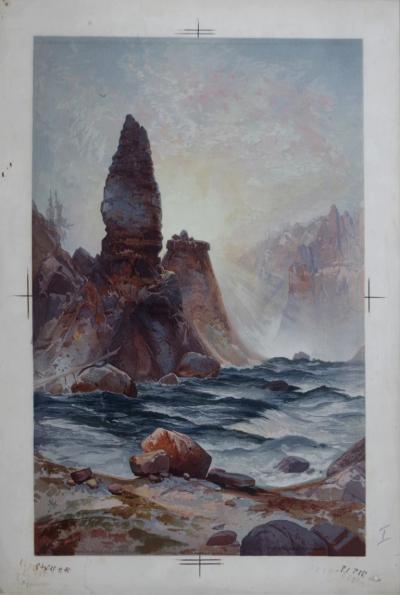Thomas Moran
American, 1837 - 1926
Thomas Moran was born in 1837 in Bolton, England, and moved to the United States at the age of seven. His family initially settled in Baltimore before relocating to Philadelphia, where Moran apprenticed as a wood engraver. Despite his early success in engraving, he gravitated towards painting, honing his skills in watercolor and oil. In 1855, he dedicated himself to a career in art, sharing a studio with his older brother, Edward, a successful marine painter.
Moran first exhibited at the Pennsylvania Academy of the Fine Arts in 1856 and soon embarked on travels to England, where he was influenced by artists like J.M.W. Turner and Claude Lorrain. His major inspiration came during a pivotal trip to the American West in 1871 with the Ferdinand V. Hayden Geological Survey. This journey introduced him to the breathtaking landscapes of Yellowstone and the Grand Canyon, which became hallmarks of his work. His painting, "The Grand Canyon of the Yellowstone," was purchased by Congress for $10,000, solidifying his reputation as a leading landscape artist.
While Moran began with marine scenes, he found his true calling in depicting the sublime beauty of nature. His works often idealized the American landscape, emphasizing the grandeur of rock formations and the interplay of light and moisture. He was instrumental in promoting the establishment of national parks through his art.
Moran eventually settled in Santa Barbara, California, where he lived until his death in 1926, leaving behind a legacy as the "Dean of American Painters." His contributions to art continue to be celebrated, with works housed in numerous prestigious collections, including the Metropolitan Museum of Art and the Los Angeles County Museum of Art.
Moran first exhibited at the Pennsylvania Academy of the Fine Arts in 1856 and soon embarked on travels to England, where he was influenced by artists like J.M.W. Turner and Claude Lorrain. His major inspiration came during a pivotal trip to the American West in 1871 with the Ferdinand V. Hayden Geological Survey. This journey introduced him to the breathtaking landscapes of Yellowstone and the Grand Canyon, which became hallmarks of his work. His painting, "The Grand Canyon of the Yellowstone," was purchased by Congress for $10,000, solidifying his reputation as a leading landscape artist.
While Moran began with marine scenes, he found his true calling in depicting the sublime beauty of nature. His works often idealized the American landscape, emphasizing the grandeur of rock formations and the interplay of light and moisture. He was instrumental in promoting the establishment of national parks through his art.
Moran eventually settled in Santa Barbara, California, where he lived until his death in 1926, leaving behind a legacy as the "Dean of American Painters." His contributions to art continue to be celebrated, with works housed in numerous prestigious collections, including the Metropolitan Museum of Art and the Los Angeles County Museum of Art.
